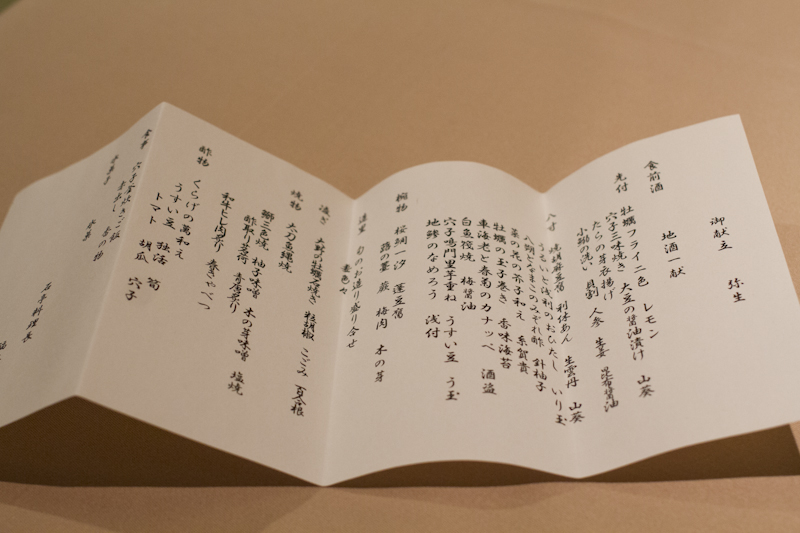
A ride was waiting for us at the station when we returned to the mainland from Miyajima.
We followed the road further down the coast, past the large circular enclosures of oyster farms which occupied the inland waters. And then we wound up the hill through smaller streets to our lodgings for the night.
A visit to an onsen (“hot spring”) is an essential part of any trip Japan, and one I always look forward to with great anticipation. Given that it’s such a volcanically active country, natural hot springs are everywhere. The Japanese flock to them to escape a hectic work life, and to spend some quiet time as a family or as a couple.
The point is to soak your cares away in scalding hot water, and then eat a massive multi-course meal with plenty of rehydrating beer.
Onsen come in all shapes and sizes, from older wooden buildings to modern hotels, and it’s always a great experience. But it’s even better when you can stay at a traditional ryokan.
According to my research, this type of Japanese inn developed during the Edo period (1603-1868), at a time when the feudal lords of different regions and their retinue were obliged to make the long pilgrimage to the military capital each year.
Ryokan served as nightly stopping places for travellers along those highways. These days they’re typically located in scenic areas rather than cities. But they still feature a traditional layout, tatami mat floors, communal baths, and the inclusion of a meal. When the communal bath uses water from an onsen (natural hot spring), you’ve got the best of both worlds.

We would only have one opportunity to visit an onsen during our 7 week stay in Japan. And so we decided to splash out — both literally and figuratively — on a beautiful hillside ryokan called Sekitei.
A phalanx of bowing workers was standing outside to great us when we pulled up to the entrance. As we walked in the door, they divested us of our luggage and bags with the skill of a pickpocket. I looked down to find that my shoes had been replaced with the largest pair of slippers they had, and we were quickly checked in and led to our rooms.
The grassy smell of tatami mat floors filled my nose with a scent like freshly cut hay as an old lady clad in a traditional kimono slid open the rice paper partitions on well-worn wooden tracks.

The room was divided into an entryway, a small sitting room with low Japanese-style table, and another room with a regular Western-style table and chairs. We were gracefully directed to sit at the table while the lady prepared delicate cups of sencha (green tea) and served us fresh seasonal sweets: sakura mochi (a pink coloured rice cake filled with sweet red bean paste and wrapped in a pickled cherry blossom leaf) and a small dish of ice cream made with sake.
She knelt on the floor beside the table and explained the features of the room, which happened to include her. Well, that’s not exactly how she said it. But she would be our personal old lady throughout our stay. And she would return later to serve us dinner, and to make up our futons for the night.

Despite the traditional appearance of the fixtures, this was a very modern hotel. The wifi was fast, air conditioners and heaters were hidden around the room, and a television was concealed in a cabinet for those who might be unimaginative enough to need empty-headed distraction from… that view!
Before she left, our old lady slid aside the partitions at the other side of the room to reveal a long sitting area with windows that looked out over the Onoseto Strait, and the island of Itsukushima, where we’d been earlier that day.

It was the sort of view you could lose yourself in for days, as the light changed and fishing boats slid past in the distance. And if your eyes grew tired of focusing on the far distance, you could shift your gaze to the beautiful Japanese garden down below, and its carp pond filled with enormous rolling gasping fish.

But we only had a couple hours before dinner, and the baths were waiting.
We changed into our yukata (a casual cotton summer kimono) and shuffled downstairs on slipper-clad feet. Sadly, mixed bathing is no longer common, and so we ducked into the separate men’s and women’s baths for a soak.
Now, if you’ve never been to a Japanese onsen, here’s how it works.
Remove your slippers outside the entryway, and leave them there. You’ll find shelves with wicker baskets inside the first small room. Take off your yukata and place it in one of the baskets, along with anything else you’re carrying. You’ll only need the tiny handkerchief-sized towel provided by the hotel.
Now go into the big room with the bath. But don’t get in just yet.
The water is shared, so you’ll need to wash off. You’ll see little shower stations all around the room. Sit on one of the tiny stools, and grab the shower nozzle (or fill the plastic bowl with water if you prefer). Help yourself to the shampoo, soap, disposable razors, and whatever else you need, and wash yourself there, taking care not to splash the water around.
And then rinse thoroughly — this is important.
If you take even a single soap bubble with you into the bath, you will contravene the Japanese concept of kitanai, and my wife will yell at you. And then I will yell at you and ask you what the hell you’re doing in the bath with my wife.
Seriously, I don’t know what it is with the Japanese and soap bubbles, but they really flip their lids if you get any in the bath, or if you leave it on the dishes when doing the washing up. So just trust me on the rinsing and do a thorough job.
Now that we’ve got that out of the way, you’re ready to take a soak.
Get up and walk over to the bath. If you’re modest, you can hold the tiny towel discretely in front of your package. Or you can strut around like me and let it all hang out. The choice is yours.
If you’re lucky, you’ll also have your choice of baths. Sekitei had two different indoor baths with differing temperatures. And they had a rotemburo: an outdoor bath, made of stone, set in a garden, and open to the sky.
I went immediately to the rotemburo and slid quietly into the scalding hot water until I was resting comfortably against the side, immersed up to my neck.
Oh yeah, remember that tiny towel you were carrying? Don’t drop it in the water. That’s “unclean” too. Fold it up and put it on top of your head until you’re ready to get back out.
There was one other man in the bath when I went out, but he left soon afterwards and I had the entire place to myself. Steam rose from the water in lazy waves, scenting the cool spring air with minerals as it drew my attention to the sky and the stars spread out in a vast celestial blanket.
I closed my eyes and sank deeper, feeling my tension and thoughts melt away, growing drowsy and relaxed, until there was nothing but the water, the heat, and the sound of the wind in the trees.
But don’t stay in too long. That water is extremely hot. You can get up and sit on the edge of the bath with just your legs immersed if you need to cool off. Or go back inside, rinse or soak in a cooler bath for a bit, and return.
When you’re so thoroughly relaxed that you feel like an invertebrate, it’s probably time to get out while you can still move under your own power. Towel off in the bath area so you don’t drip water all over the changing room. And then go back to the entry room, get your yukata from the basket, and get dressed.

My wife and I happened to emerge from the baths at exactly the same time, and so we made our way to the lounge room overlooking the gardens, where we were served an ice cold glass of beer: the perfect rehydration solution after all that heat.
Several small flasks of sake had been set out on a table nearby, with tiny ceramic cups. All were local to the region, but each was a different style. An older couple who was seated in the lounge encouraged us to try them.
I diligently made my way through all seven. And when a staff member came over to ask us which was our favourite, we chose a clean, fragrant Junmai Ginjo called “Ugo no Tsuki” (“the moon after rain”). It would make another appearance later in the evening when we were given a bottle to enjoy with our dinner.

And now that we were thoroughly relaxed and slightly pickled, it was time to move on to the other main event of our stay. As always in Japan, it would be centred on food.
An onsen dinner is a multi-course affair which plays out slowly over two or three hours. The term for it is kaiseki-ryori, and it uses fresh, seasonal ingredients from the local region — both sea and mountain — to create a semi-magical balance of taste, texture, appearance and colour.

The ceramic dishes are also changed according to the season, and each plate is decorated with seasonal leaves and flowers, and with edible garnishes designed to resemble plants or animals.

Our table was ready when we returned to our room, and we took our seats as our personal old lady slipped in to serve us one dish after another, vanishing discretely while we ate, and returning later with each new course.
Our dinner included several variations on the two main regional specialties: kaki (oysters — grown in the waters right below us), and anago (salt water eel). And of course the usual sashimi, tender Japanese beef, sansai (wild mountain vegetables, including fiddleheads), red sea bream, fermented pickles, rice with anago, and fresh fruit with black sesame ice cream for dessert. All that and more.





When dinner was finally over, we retired to the sitting area with views over the sea while the table was cleared and moved aside, and the lady prepared our futons on the floor.

Onsen nights tend to be early. By the time you’ve soaked in the bath, soaked yourself with sake, and polished off a 9-course meal, that big fluffy futon looks pretty inviting. And I promise you’ll have one of the deepest and most peaceful sleeps of your life.
You’ll need it, because breakfast is another — albeit smaller — multi-course affair. It was served in our room too, after the staff had folded away our futons.

And we just had time for another bath in the deep wooden tub in our room, complete with garden view, before it was time to leave.
The ryokan staff accompanied us out the door to the van, and an employee drove us down to the nearest train station, where we caught the local back to Hiroshima, and transferred to a Shinkansen bound for the island of Kyushu.
That’s where the adventure continued. And I’ll tell you about it in the next instalment.
Photos ©Tomoko Goto 2016

Get your FREE Guide to Creating Unique Travel Experiences today! And get out there and live your dreams...
